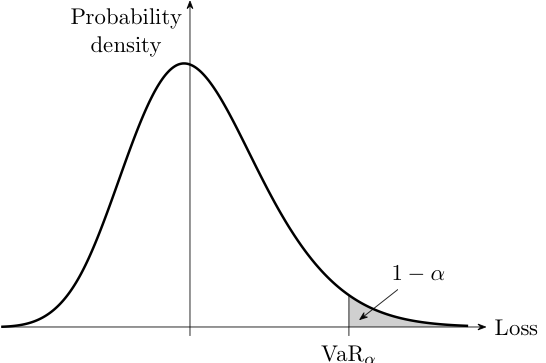Not sure if this counts as "not drawing it manually", but at the moment, the line below the origin comes from `enlarge y limits={value=.02,lower}`. You could instead set `ymin` to the same value as your tick at VaR.
The reason `enlarge y limits={value=.02,lower}` did not work as expected is that this seems to be a relative value. From the `pgfplots` docu:
> `\pgfplotsset{enlarge x limits={value=0.2,upper}}` will enlarge (only) the upper axis limit by 20% of the axis range.
```
\documentclass[11pt]{standalone}
% tikz
\usepackage{tikz}
\usepackage{pgfplots}
\pgfplotsset{compat=newest}
\usetikzlibrary{arrows.meta}
\usetikzlibrary{positioning}
\usetikzlibrary{backgrounds}
\pgfplotsset{
assi/.style={
axis lines=middle,
axis line style={-Stealth},
ticks=none,
samples=300,
clip=false,
},
}
\usetikzlibrary{math}
\tikzmath{%
function h1(\x, \lx) { return (9*\lx + 3*((\lx)^2) + ((\lx)^3)/3 + 9); };
function h2(\x, \lx) { return (3*\lx - ((\lx)^3)/3 + 4); };
function h3(\x, \lx) { return (9*\lx - 3*((\lx)^2) + ((\lx)^3)/3 + 7); };
function skewnorm(\x, \l) {
\x = (\l < 0) ? -\x : \x;
\l = abs(\l);
\e = exp(-(\x^2)/2);
return (\l == 0) ? 1 / sqrt(2 * pi) * \e: (
(\x < -3/\l) ? 0 : (
(\x < -1/\l) ? \e / (8 * sqrt(2 * pi)) * h1(\x, \x*\l) : (
(\x < 1/\l) ? \e / (4 * sqrt(2 * pi)) * h2(\x, \x*\l) : (
(\x < 3/\l) ? \e / (8 * sqrt(2 * pi)) * h3(\x, \x*\l) : (
sqrt(2/pi) * \e)))));
};
}
\begin{document}
\begin{tikzpicture}
\begin{axis}[
assi,
enlarge x limits={value=.04,upper},
% enlarge y limits={value=.03,lower},
ymin=-0.02,
ymax=.73,
xscale=1.2,
xlabel = {Loss},
x label style={at=(current axis.right of origin),
anchor=west},
ylabel = {Probability\\ density},
y label style={%at=(current axis.above origin),
anchor=north east, align=center, %inner sep=0pt
},
]
\pgfmathsetmacro{\limiteinf}{-1.9}
\pgfmathsetmacro{\limitesup}{2.8}
\pgfmathsetmacro{\VaRx}{1.6}
\pgfmathsetmacro{\VaR}{skewnorm(\VaRx+.6,2)}
\begin{scope}[on background layer]
\addplot[fill=gray!30, draw=none, domain=\VaRx:\limitesup]
{skewnorm((x+.6), 2)} \closedcycle;
\end{scope}
\addplot[very thick, domain=\limiteinf:\limitesup] {skewnorm((x+.6), 2)};
\draw (axis cs:\VaRx,0) -- (axis cs:\VaRx,\VaR);
\draw (axis cs:\VaRx,0) -- (axis cs:\VaRx,-.02)
node[below=4pt, inner sep=0pt] {$\mathrm{VaR}_\alpha$};
\node (unomenoalfa) at (axis cs:2.3,0.12) {$1-\alpha$};
\draw[-Stealth] (unomenoalfa) -- (axis cs:1.7,0.015);
\end{axis}
\end{tikzpicture}
\end{document}
```
